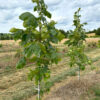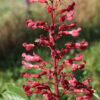A tree with a common name with ‘swamp’ in it might make you think it thrives in permanently wet environments, however, the swamp white oak (Quercus bicolor) prefers moist soil that dries out occasionally. It grows naturally along streams and rivers and can tolerate spring floods but also can handle periods of drought as it develops a bi-layer root system: the upper roots grow fine when being submerged by flood waters and the deeper roots seek soil moisture during dry times.
This is a usual weather pattern here in the Shenandoah Valley where Page County receives 39 inches of annual rainfall with typically wet springs and periods of drought in August and September.
Swamp white oak is often found growing alongside other bottomland species such as hackberry, black walnut, shingle and pin oaks, American elm, silver maple and river birch. It grows comparatively fast, attaining mature heights of 60-70 feet (considered medium height by tree standards) with a trunk diameter of 2-3 feet.
Among the other oak species which thrive in hydric habitats are the overcup oak, swamp chestnut, shingle, bur and cherrybark oak. Those which grow best in xeric conditions are post oak, blackjack, bear, chinquapin and chestnut oak.
In the landscape, swamp white oak likes more acidic soil and is vulnerable to soil chlorosis (where soil is too alkaline) and should be planted where the pH is about 4.5-6.0.
The Latin name bicolor refers to the two-toned leaves – glossy green on top and silver white underneath. The underside is glaucus and feels almost like soft fur, an easy identifying characteristic.
Swamp white oaks are legacy trees, growing for 350 years or more. These ancient sentinels are witness to much human history but sometimes get intertwined with our dramas and sadder sagas. Such is the case with the swamp white oak in Highland County included in the Remarkable Trees of Virginia book*.
Some stories associate this tree with hangings but the oral history most validated is that it grew in proximity to a European homestead which had encroached on Native American’s ancestral lands. In 1763, a fight broke out when warriors enforced the established boundaries as agreed to in signed treaties. Several Europeans were killed and we do not know how many Indigenous people lost their lives. Native deaths are not often included with accounts of such encroachments.
 What we do know is this swamp white oak tree has lived in an open meadow looks and, due to its size, appears like it could have been alive in the 1700s. It also happens to be the state champion, towering upwards for 70 feet and solidly anchored by a trunk that is almost eight feet in diameter.
What we do know is this swamp white oak tree has lived in an open meadow looks and, due to its size, appears like it could have been alive in the 1700s. It also happens to be the state champion, towering upwards for 70 feet and solidly anchored by a trunk that is almost eight feet in diameter.
 In summary, swamp white oak makes a great shade tree in the landscape and is a great choice for problematic areas which are wet in the spring and experience drought in the fall.
In summary, swamp white oak makes a great shade tree in the landscape and is a great choice for problematic areas which are wet in the spring and experience drought in the fall.
Chris Anderson
White House Farm Foundation
Luray, VA









